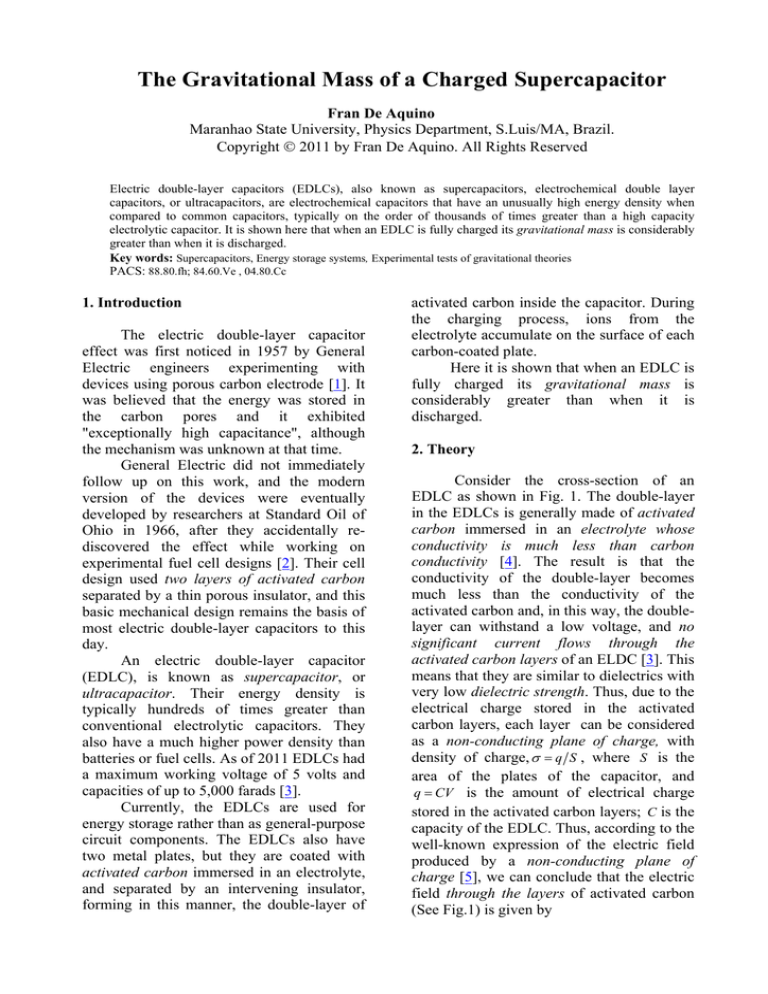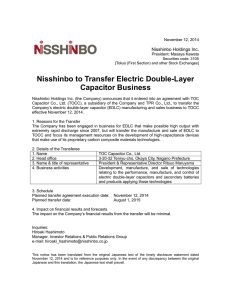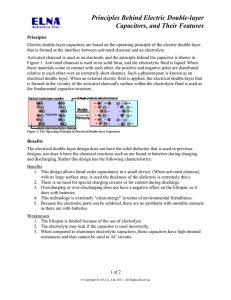
The Gravitational Mass of a Charged Supercapacitor
Fran De Aquino
Maranhao State University, Physics Department, S.Luis/MA, Brazil.
Copyright © 2011 by Fran De Aquino. All Rights Reserved
Electric double-layer capacitors (EDLCs), also known as supercapacitors, electrochemical double layer
capacitors, or ultracapacitors, are electrochemical capacitors that have an unusually high energy density when
compared to common capacitors, typically on the order of thousands of times greater than a high capacity
electrolytic capacitor. It is shown here that when an EDLC is fully charged its gravitational mass is considerably
greater than when it is discharged.
Key words: Supercapacitors, Energy storage systems, Experimental tests of gravitational theories
PACS: 88.80.fh; 84.60.Ve , 04.80.Cc
1. Introduction
The electric double-layer capacitor
effect was first noticed in 1957 by General
Electric engineers experimenting with
devices using porous carbon electrode [1]. It
was believed that the energy was stored in
the carbon pores and it exhibited
"exceptionally high capacitance", although
the mechanism was unknown at that time.
General Electric did not immediately
follow up on this work, and the modern
version of the devices were eventually
developed by researchers at Standard Oil of
Ohio in 1966, after they accidentally rediscovered the effect while working on
experimental fuel cell designs [2]. Their cell
design used two layers of activated carbon
separated by a thin porous insulator, and this
basic mechanical design remains the basis of
most electric double-layer capacitors to this
day.
An electric double-layer capacitor
(EDLC), is known as supercapacitor, or
ultracapacitor. Their energy density is
typically hundreds of times greater than
conventional electrolytic capacitors. They
also have a much higher power density than
batteries or fuel cells. As of 2011 EDLCs had
a maximum working voltage of 5 volts and
capacities of up to 5,000 farads [3].
Currently, the EDLCs are used for
energy storage rather than as general-purpose
circuit components. The EDLCs also have
two metal plates, but they are coated with
activated carbon immersed in an electrolyte,
and separated by an intervening insulator,
forming in this manner, the double-layer of
activated carbon inside the capacitor. During
the charging process, ions from the
electrolyte accumulate on the surface of each
carbon-coated plate.
Here it is shown that when an EDLC is
fully charged its gravitational mass is
considerably greater than when it is
discharged.
2. Theory
Consider the cross-section of an
EDLC as shown in Fig. 1. The double-layer
in the EDLCs is generally made of activated
carbon immersed in an electrolyte whose
conductivity is much less than carbon
conductivity [4]. The result is that the
conductivity of the double-layer becomes
much less than the conductivity of the
activated carbon and, in this way, the doublelayer can withstand a low voltage, and no
significant current flows through the
activated carbon layers of an ELDC [3]. This
means that they are similar to dielectrics with
very low dielectric strength. Thus, due to the
electrical charge stored in the activated
carbon layers, each layer can be considered
as a non-conducting plane of charge, with
density of charge, σ = q S , where S is the
area of the plates of the capacitor, and
q = CV is the amount of electrical charge
stored in the activated carbon layers; C is the
capacity of the EDLC. Thus, according to the
well-known expression of the electric field
produced by a non-conducting plane of
charge [5], we can conclude that the electric
field through the layers of activated carbon
(See Fig.1) is given by
E(layer) = E − = E + =
2
σ
2ε r (layer)ε 0
=
CV
2ε r (layer)ε 0 S
(1)
Consequently, the density of electromagnetic
energy in the carbon layers is
2
Wlayer = 12 ε r (layer)ε 0 Elayer
=
⎛ CV ⎞
⎜
⎟
8ε r (layer)ε 0 ⎝ S ⎠
1
2
(2)
It was shown that the relativistic
gravitational mass M g is correlated with the
relativistic inertial mass M i by means of the
following factor [6]:
M g = χ Mi
(3)
where χ can be expressed by
⎧
2
⎤⎫
⎡
⎛nW⎞
⎪
⎥⎪
⎢
χ = ⎨1 − 2⎢ 1 + ⎜ r 2 ⎟ −1⎥⎬
⎜ρ c ⎟
⎪
⎥⎪
⎢
⎝
⎠
⎦⎭
⎣
⎩
(4)
where n r is the refraction index and ρ the
density of the material.
Substitution of Eq. (2) into Eq. (4),
yields
⎧
2
⎡
⎤⎫
⎡ nr(layer)μ0 ⎛ CV ⎞2 ⎤
⎪
⎢
⎥⎪
χ = ⎨1 − 2⎢ 1 + ⎢
⎜
⎟ ⎥ − 1⎥⎬ (5)
⎢⎣8ε r(layer)ρlayer ⎝ S ⎠ ⎥⎦
⎪
⎢
⎥⎪
⎣
⎦⎭
⎩
In the case of activated carbon layer:
nr(layer) ≅ 1 ; ε r(layer) ≅ 12 and ρ layer ≅ 800kg.m −3 .
Thus, if the supercapacitor has C = 3,000F ;
S = 0.08 × 0.45 = 0.036m 2 and is subjected to
V = 4Volts then Eq. (5) gives
χ = −1.14
(6 )
Substitution of Eq.(6) into Eq. (3) yields
M g (layer) = −1.14 M i(layer) = 1.14M i(layer)
(7)
This means an increase of 14% in the
gravitational mass of the double-layer when
the supercapacitor is fully charged. Since
the mass of the double-layer is a significant
part of the total mass of the supercapacitor,
we can conclude that, when fully charged the
supercapacitor will display considerably
more mass than when it is discharged.
It is important to note that the
gravitational mass of the double-layer can
also be reduced, decreasing the total mass of
the supercapacitor. This can occur, for
example, when 1.5Volts < V < 3.1Volts .
Conclusion
The theoretical results here obtained
for the gravitational mass of an EDLC are
general for energy accumulator cells which
contain non-conducting planes of charges
similar to the activated carbon + electrolyte
layers of the EDLCs.
3
Activated Carbon layer
+
Electrolyte
Electrode
−
−
−
−
−
+
−
+
E−
−
−
−
−
−
+
−
+
+
+
+
+
−
−
E+
+
−
+
+
+
+ E
−
−
+
+
−
−
+
+
−
E−
+
+
−
−
+
Insulator
+
+
+
+
+
−
d
Fig. 1 – Cross-section of an Electric Double-Layer Capacitor (Supercapacitor) - Each activated
carbon + electrolyte layer works as a non-conducting plane of charge, with density of charge
σ − = q − S and σ + = q + S respectively. The electric fields through the layers, due to these
(
)
densities of charges E − , E + , are shown in the figure above.
4
References
[1] Becker, H.I., (1957) Low voltage electrolytic capacitor,
US Patent 2800616 (A), 1957-07-23.
[2] Schindall, J. (2007) The Charge of the Ultra-Capacitors,
IEEE Spectrum, November 2007.
[3] Electric Double-Layer Capacitor http://en.wikipedia.org/
wiki / Electric_double-layer_capacitor
[4] Miller, J. and Simon, P. (2008) Fundamentals of
Electrochemical Capacitor Design and Operation, The
Electrochemical Society Interface, Spring 2008.
[5] Halliday, D. and Resnick, R. (1966) Physics, vol.2, John
Wiley & Sons, NY. Portuguese version (1968) Física,
Vol. 2, Ao Livro Técnico SA, Rio de Janeiro, Brasil,
pp. 768-769.
[6] De Aquino, F. (2010) Mathematical Foundations of the
Relativistic Theory of Quantum Gravity, Pacific Journal
of Science and Technology, 11(1), pp. 173-232.


